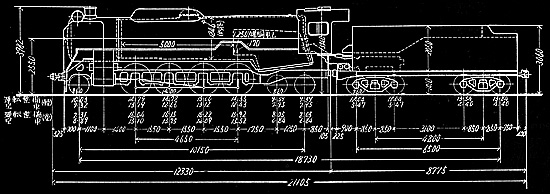As a result, heavy axle loaded class D52 was altered with a relieved axle load (4-8-2 to 4-8-4). Concurrently with axle arrangement reconstruction, D-52s coarse parts made during the war were replaced to normal modern parts, and the class named D62 came into being.
The first D62 came on the scene from the D52_368 in 1950. A total of 20 D62s were made from 1950 and 1951.
According to the original plan, a total of 500 heavy engines would be remodeled. But definitely this number was grossly reduced, because of earlier electrification and dieselization progress. Originally it was planned to have more than 20 engines, but they were suspended after 20.
The D62 appeared in the year of 1950, because electrification progress was still slow. Therefore, D62s still worked on arterious main lines of Tokaido and Sanyo, together with heavy axle loaded D52s, for another 10 years. Thus, there was no point in axle load relief, during this 10 year period.
But, when the Sanyo line began electrification during 1959 at Himeji, the D62 came into play with axle load relief remodeling. All D62s were moved to the Tohoku line, Ichinoseki depot, and worked between Sendai and Morioka.

D62_4 Maibara depot. 1950. (Photo credit to K.Nishio) |
The D62_20 was regarded as the "Good-bye D62" train at the Nagamachi (Sendai) yard on the 30th September, 1966. The last three D62s were D62_10, 15 and 20. Afterward, "The Largest Japanese Freight type engine D62" was considered for preservation. But in the end, all engines were scrapped during 1966.
| Primary ran line in last 10 years |
Tohoku line (Nagamachi, Sendai-Morioka)
| Last line/depot and year |
Tohoku line / Ichinoseki depot.1966.
| Restored engine |
none
| Preserved engine |
none
| |

| Configuration | 2-8-4 | Dimensions Length (mm) | 21105 |
| Engine Weight (Operating tons) | 87.9 | Driver size (mm diameter) | 1400 |
| Boiler pressure (Kg/cm2) | 16.0 | Max Tractive effort (tons) | 14.8 |
| Driver Max Power (PS) | 1660 | Max Speed (km/h) | 85 |
| Manufactured years | 1950-1951 | Total production | 20 |
| Gauge | 3ft 6in (1067mm) |
Introduction |
Go to Top |